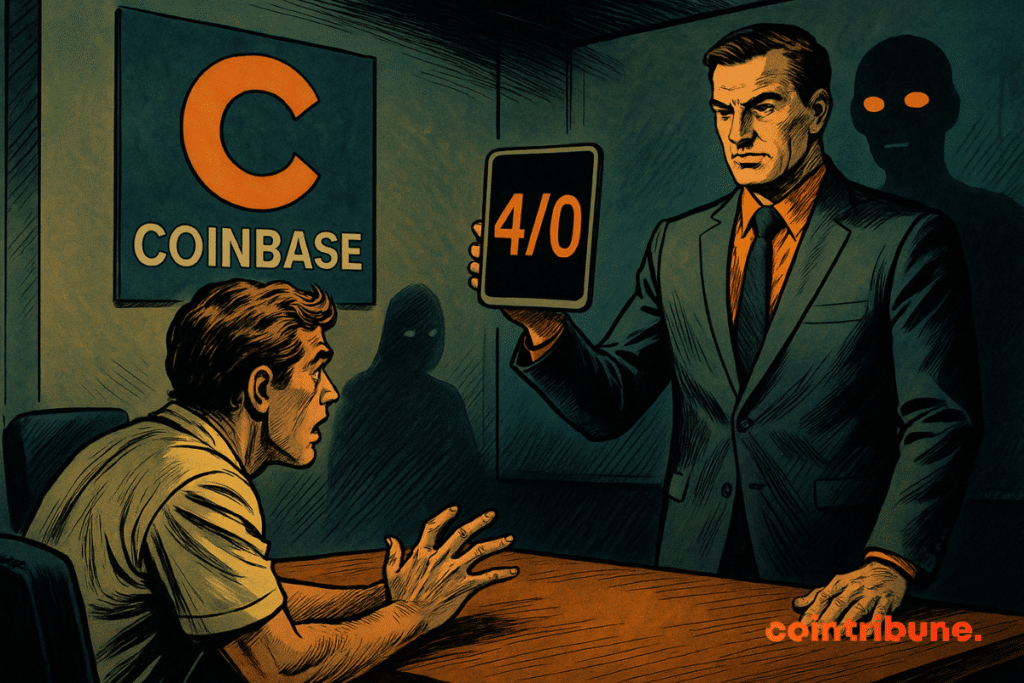Coinbase bets on AI to write half of its code by October
Artificial intelligence is establishing itself in all sectors, sometimes as an ally, sometimes as a silent tyrant. Can it still be stopped? Or are we living the beginning of a real rush for digital gold? At Coinbase, the answer is already clear: accelerate, even if it means shaking up its teams. The crypto exchange acknowledges having crossed a decisive step by entrusting nearly half of its code to AI, and its CEO Brian Armstrong is pushing even further.

In brief
- Brian Armstrong confirms that 40% of Coinbase’s code is generated by AI.
- The goal set is to exceed 50% AI code by next October.
- Armstrong mandated the obligatory use of Copilot and Cursor under threat of dismissal.
- Crypto hiring is declining while AI now attracts talents and global investments.
Coinbase turns its code into an AI laboratory
At Coinbase, AI is no longer an experiment but a daily reality. According to Brian Armstrong, 40% of code lines are now generated by AI, compared to less than 20% a few months ago. The goal is clear: reach 50% by October. For Armstrong, “we must use AI responsibly as much as possible.”
The CEO also highlights spectacular results. At Coinbase, some engineers now manage to refactor, update, or build new systems in a few days, whereas it previously took months. This shortening of deadlines illustrates the promise brandished by Armstrong: multiply productivity, capable of reshaping how a crypto exchange builds and maintains its infrastructure.
The tools used are numerous: GitHub Copilot, Cursor, Claude Code, Cody, JetBrains. More than 1,500 engineers use them daily. The crypto exchange even monitors token consumption as a productivity indicator.
By showing these figures, Coinbase sends a strong message to investors: the publicly traded company wants to be seen as a pioneer of automation in crypto finance.
Armstrong, a boss who enforces AI at forced march
Behind this transition lies a brutal method. Armstrong gave his engineers one week to adopt GitHub Copilot and Cursor.
I told myself: AI is important. You all need to learn it and at least get familiar with it. You don’t need to use it every day immediately, we will provide training, but you must at least adopt it by the end of the week… Some had a good reason, because they were just coming back from a trip or something else. Others had none, and they were fired.
These words shocked some of his teams, but Armstrong stands by this shift. For him, the future of Coinbase relies on an “AI-native” workforce, trained to work with these new tools.
The crypto exchange has also set up “AI speedruns”: each month, an employee who has brilliantly integrated AI leads a workshop to share their practices.
If this approach worries by its brutality, Armstrong presents it as a necessary step. In a sector dominated by speed and competition, lagging behind in AI would be a strategic suicide.
Crypto engineers or “AI-native”? The market pivots
This mutation goes beyond the Coinbase exchange. Since 2022, crypto hiring has declined. As Raman Shalupau from CryptoJobsList explains, “developers and entrepreneurs go where the money and excitement are. Right now, AI attracts both.”
Coinbase illustrates this shift. Development teams now work in an ecosystem saturated with AI assistants, where speed trumps traditional methods. But this race for efficiency raises concerns.
The massive use of AI has caused a rise in bugs. To address this, Coinbase created a “repository sensitivity matrix” to limit risks on sensitive projects.
Key points to remember
- 40% of Coinbase code is generated by AI, goal: 50% by October;
- More than 1,500 engineers use Cursor and Copilot daily;
- Since 2022, crypto hiring declines in favor of AI projects;
- Layoffs sanctioned employees resistant to AI adoption.
In this context, Coinbase is no longer just a crypto exchange: it becomes a symbol of a new era where the “AI-native” engineer takes precedence over the classic crypto engineer. But one question remains: how far can this dependency on machine code go without weakening security?
AI divides opinion, in finance as elsewhere. On American campuses, it already sparks intense debates on learning and academic integrity. Meanwhile, Washington sees it as an economic and strategic driver. Between fear and fascination, the line remains thin, and the future belongs to those who will tame the machine.
Maximize your Cointribune experience with our "Read to Earn" program! For every article you read, earn points and access exclusive rewards. Sign up now and start earning benefits.
La révolution blockchain et crypto est en marche ! Et le jour où les impacts se feront ressentir sur l’économie la plus vulnérable de ce Monde, contre toute espérance, je dirai que j’y étais pour quelque chose
The views, thoughts, and opinions expressed in this article belong solely to the author, and should not be taken as investment advice. Do your own research before taking any investment decisions.